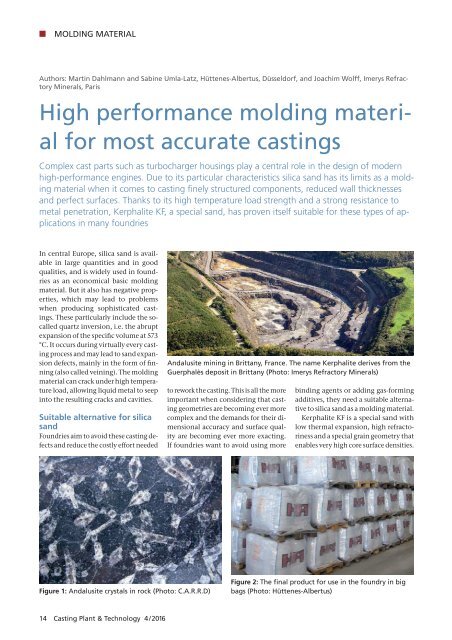CPT International 04/2016
The leading technical journal for the global foundry industry – Das führende Fachmagazin für die weltweite Gießerei-Industrie
The leading technical journal for the
global foundry industry – Das führende Fachmagazin für die
weltweite Gießerei-Industrie
Create successful ePaper yourself
Turn your PDF publications into a flip-book with our unique Google optimized e-Paper software.
K MOLDING MATERIAL<br />
Authors: Martin Dahlmann and Sabine Umla-Latz, Hüttenes-Albertus, Düsseldorf, and Joachim Wolff, Imerys Refractory<br />
Minerals, Paris<br />
High performance molding material<br />
for most accurate castings<br />
Complex cast parts such as turbocharger housings play a central role in the design of modern<br />
high-performance engines. Due to its particular characteristics silica sand has its limits as a molding<br />
material when it comes to casting finely structured components, reduced wall thicknesses<br />
and perfect surfaces. Thanks to its high temperature load strength and a strong resistance to<br />
metal penetration, Kerphalite KF, a special sand, has proven itself suitable for these types of applications<br />
in many foundries<br />
In central Europe, silica sand is available<br />
in large quantities and in good<br />
qualities, and is widely used in foundries<br />
as an economical basic molding<br />
material. But it also has negative properties,<br />
which may lead to problems<br />
when producing sophisticated castings.<br />
These particularly include the socalled<br />
quartz inversion, i.e. the abrupt<br />
expansion of the specific volume at 573<br />
°C. It occurs during virtually every casting<br />
process and may lead to sand expansion<br />
defects, mainly in the form of finning<br />
(also called veining). The molding<br />
material can crack under high temperature<br />
load, allowing liquid metal to seep<br />
into the resulting cracks and cavities.<br />
Suitable alternative for silica<br />
sand<br />
Foundries aim to avoid these casting defects<br />
and reduce the costly effort needed<br />
Andalusite mining in Brittany, France. The name Kerphalite derives from the<br />
Guerphalès deposit in Brittany (Photo: Imerys Refractory Minerals)<br />
to rework the casting. This is all the more<br />
important when considering that casting<br />
geometries are becoming ever more<br />
complex and the demands for their dimensional<br />
accuracy and surface quality<br />
are becoming ever more exacting.<br />
If foundries want to avoid using more<br />
binding agents or adding gas-forming<br />
additives, they need a suitable alternative<br />
to silica sand as a molding material.<br />
Kerphalite KF is a special sand with<br />
low thermal expansion, high refractoriness<br />
and a special grain geometry that<br />
enables very high core surface densities.<br />
Figure 1: Andalusite crystals in rock (Photo: C.A.R.R.D)<br />
Figure 2: The final product for use in the foundry in big<br />
bags (Photo: Hüttenes-Albertus)<br />
14 Casting Plant & Technology 4 / <strong>2016</strong>


















